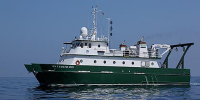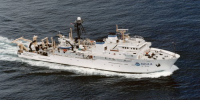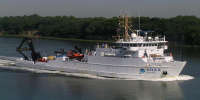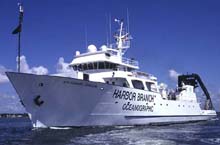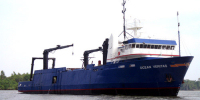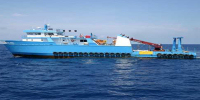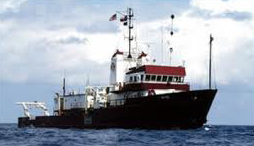
Historical Petroleum and Oil Spill Research
On June 3, 1979, the exploratory oil well Ixtoc-1 located 600 miles south of Texas in Mexico's Bay of Campeche, suffered a blowout. For nearly 10 months, millions of barrels of oil spilled into the ocean covering a 1,100-square-mile area in the Gulf of Mexico. Hundreds of miles of Mexican and US coastal areas were eventually affected by the oil spill. AOML's then Ocean Chemistry Division (now the Ocean Chemistry and Ecosystems Division) conducted one of the only research cruises to study the impact of the 1979 Ixtoc-1 oil spill in the southern Bay of Campeche and has contributed to other oil spill research in the Gulf of Mexico. The report from the cruise, along with publications about AOML's research on floating tar from the Ixtoc-1 spill and other oil spill related research done prior to the Deepwater Horizon spill can be found at the following links:
- The Ixtoc-1 Research Cruise Prelimary Report. [website]
- An Example Study of the Weathering of Spilled Petroleum in a Tropical Marine Environment: Ixtoc-1 (1982). [pdf]
- Observation of a Subsurface Oil-Rich Layer in the Open Ocean. [pdf]
- The Blind Pass Petroleum in Sediments (PB-PES) program. [website]
- Results of the CARIPOL Petroleum Pollution Monitoring Project in the Wider Caribbean. [pdf]
- The CARIPOL Petroleum Pollution Monitoring Project and the CARIPOL Petroleum Pollution Database. [pdf]
- Floating Tar and Dissolved/Dispersed Petroleum Hydrocarbons in the Northern Gulf of Mexico and the Straits of Florida. [pdf]
- Stranded Tar on Florida Beaches: September 1979 - October 1980. [pdf]
Deepwater Horizon Research
Scientists from AOML's Ocean Chemistry and Ecosystems Division participated in a number of research cruises, conferences, and provided substantial scientific support for NOAA's response to the Deepwater Horizon oil spill. The Division also supplied instrumentation for NOAA vessels, quality control for Winkler titrations needed to calibrate oxygen sensors, and contributed to studies of oil distribution in beach and coral reef regions of Florida. Additional AOML Deepwater Horizon activities are detailed here .
Research Cruises
Dr. Michelle Wood, Director of AOML's Ocean Chemistry and Ecosystems Division was Chief Scientist and Mr. Charles Featherstone of the Ocean Chemistry and Ecosystems Division provided scientific support in the R/V Walton Smith Deepwater Horizon Cruise, June 6 - June 10, 2010. [Mission Report/ Pictures]
Mr. Shailer Cummings of the Ocean Chemistry and EcosystemsDivision participated in the R/V Gordon Gunter Cruise, May 27 - June 4, 2010. [Mission Report]
Mr. Shailer Cummings of the Ocean Chemistry and Ecosystems Division participated in the R/V Nancy Foster Loop Current Cruise, June 30 - July 18, 2010. [Mission Report]
Dr. Michelle Wood, Director of AOML's Ocean Chemistry and Ecosystems Division was responsible for interpreting and managing a range of water column measurements during a leg of the R/V Seward Johnson Florida Shelf-Edge Expedition (FLoSEE) Cruise, July 9 - August 9, 2010. [Website]
Mr. George Berberian of the Ocean Chemistry and Ecosystems Division provided high-quality dissolved oxygen analyses during the R/V Ocean Veritas Deepwater Horizon Cruise #12, August 1 - August 2, 2010. [Report]
Mr. George Berberian of the Ocean Chemistry and Ecosystems Division provided high-quality dissolved oxygen analyses during the R/V Brooks McCall Deepwater Horizon Cruise #16 (Legs 1 & 2), August 4 - August 11, 2010. [Report] Fieldwork and Research
Working with colleagues from EPA, NOAA-ORR, the University of South Florida, Louisiana State University, Canada's Dept. of Fisheries and Oceans, the Alliance for Coastal Technology, Dalhousie University, the Oil Spill Recovery Institute, and several corporations, former Ocean Chemistry and Ecosystems Director Michelle Wood organized a study at DFO's Center for Offshore Oil and Gas Energy Research to evaluate the sensitivity and linearity of response for different flourometers used to detect subsurface oil during the Deepwater Horizon event. Chris Kelble from AOML also participated in the study, and Shailer Cummings provided technical support.
Mr. Charles Featherstone of the Ocean Chemistry and Ecosystems Division participated in a study of oil-beach interactions with Dr. Ping Wang, University of South Florida on beaches in northern Florida and Alabama. Mr. Featherstone provided the technical expertise needed to operate AOML's profiling fluorometer for detecting oil in sediment cores.
Dr. Denis Pierrot, Mr. George Berberian, and Mr. Robert Castle of the Ocean Chemistry and Ecosystems Division travelled to Key West, Florida, Port Fourchon, Louisiana, and Pascagoula, Mississippi to deliver equipment and train technicians to perform shipboard sampling and analyses. The ship's serviced included the NOAA Ships Henry Bigelow and Pisces and the BP charter vessels Ocean Veritas and Brooks McCall.
The Joint Analysis Group (JAG)
Dr. Richard Wanninkhof has been an active member of the Joint Analysis Group (JAG) for Surface and Sub-Surface Oceanography, Oil and Dispersant Data since its founding shortly after the spill began. The JAG is a collaborative effort between the National Oceanic and Atmospheric Administration (NOAA), the U.S. Environmental Protection Agency (EPA) and the White House Office of Science and Technology Policy (OSTP). JAG was developed to ensure a comprehensive and coordinated analysis of the oceanographic data collected in the Gulf of Mexico by private, federal and academic scientists. - [website]
Publications
Ryan, J.P., Y. Zhang, H. Thomas, E.V. Reinecker, R.K. Nelson, and S.R. Cummings. A High-resolution Survey of a Deep Hydrocarbon Plume in the Gulf of Mexico during the 2010 Macondo Blowout. Monitoring and Modelling the Deepwater Horizon Oil Spill, pp. 63-67, 2011. Ed. by Y. Liu, A. MacFadyen, J-G. Ji and R.H. Weisburg. American Geophysical Union.
Shay, L.K., B. Jaimes, J.K. Brewster, P. Meyers, E. Claire Caskill, E. Uhlhorn, F. Marks, G.R. Halliwell, O.M. Smedstad, and P. Hogan. Airborn Ocean Surveys of the Loop Current Complex from NOAA WP-3D in Support of the Deepwater Horizon Oil Spill. Monitoring and Modelling the Deepwater Horizon Oil Spill, pp. 131-152, 2011. Ed. by Y. Liu, A. MacFadyen, J-G. Ji and R.H. Weisburg. American Geophysical Union.
Atwood, D. K., F. J. Burton, J. E. Corredor, G. R. Harvey, A. J. Mata-Jimenez, A. Vasquez-Botello, and B. A. Wade. Results of the CARIPOL Petroleum Pollution Monitoring Project in the Wider Caribbean. Marine Pollution Bulletin, Vol. 18 (10), 540-548, 1987.
Atwood, D. K., H. H. Cummings, W. J. Nodal, and R. Culbertson. The CARIPOL Petroleum Monitoring Project and the CARIPOL Petroleum Pollution Database. Caribbean Journal of Science, Vol. 23 (1), 1-3, 1987.
Atwood, D. K. and S. Dinkel-McKay. Floating Tar and Disssolved Dispersed Petroleum Hydrocarbons in the Northern Gulf of Mexico and the Straits of Florida. Caribbean Journal of Science, Vol. 23 (1), 73-76, 1987.
Atwood, D. K. and R. L. Ferguson. An Example Study of the Weathering of Spilled Petroleum in a Tropical Marine Environment: Ixtoc-1. Bulletin of Marine Science, 32(1): 1-13, 1982.
Romero, G. C., G. R. Harvey and D. K. Atwood. Stranded Tar on Florida Beaches: September 1979 - October 1980. Marine Pollution Bulletin, Vol. 12 (8), 280-284, 1981.
Harvey, G. R., A. G. Requejo, P. A. McGillivary, and J. M. Tokar. Observation of a Subsurface Oil-Rich Layer in the Open Ocean. Science, Vol. 205 (4410), 999-1001, 1979.
